The DSP Concepts Blog
.png?height=350&name=Blog_speakerphone_v1_053123%20(1).png)
Why full-duplex operation in speakerphones is so important
by Brent Butterworth
In full-duplex communications, people on both ends of the line can talk and be heard without the two sides interfering with each other. Whether you’re using an Ethernet connection or an old analog phone line, the technology for full-duplex communication is well-established and...
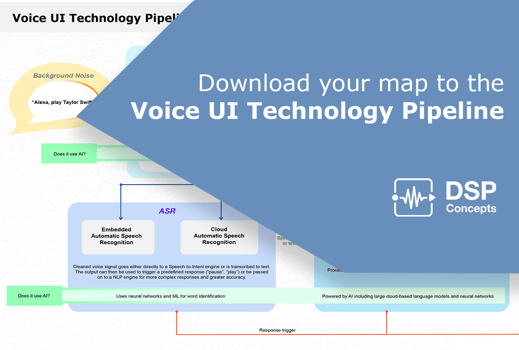
Voice UI Technology Pipeline
The technology pipeline that makes voice UI work is complex. For consumers, the signal flow is neatly hidden under-the-hood of the smart device. For product makers, coordinating all of the parts to achieve a seamless experience is challenging. This infographic captures the full pipeline in a...
.png?height=350&name=BLOG_Automotive_Toolbox_032823%20(1).png)
Toolbox vs. Black Box
Enabling Differentiation in Automotive Voice
For auto makers seeking to incorporate voice control and voice communication systems, DSP Concepts recognizes that there are multiple approaches to leverage supplier expertise and save in-house resources.

The Confidence to Speak Naturally
Providing drivers with high-quality voice control and communication features can avoid distractions such as the passengers feeling compelled to speak loudly, drivers leaning awkwardly in their seats in order to be heard, or drivers interacting directly with their phones. For many end-users, these...
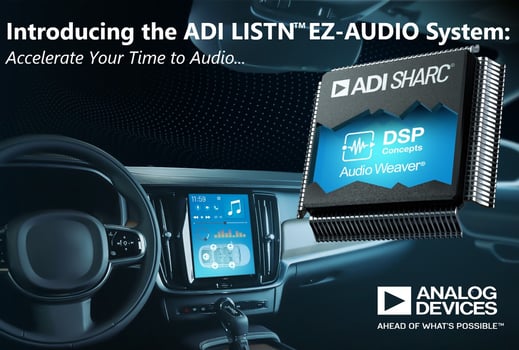
The Out-of-the-Box Full In-Car Audio System
ADI LISTN(TM) EZ-AUDIO System with DSP Concepts Audio Weaver and AWE Tune optimized for SHARC+
Following the recent optimization of Audio Weaver® Core runtime libraries for SHARC+® series processors, Analog Devices, Inc. and DSP Concepts have partnered together in the development of a full in-car...

Forrester Research: The Audio Weaver ROI Interview
DSP Concepts commissioned Forrester Research to conduct a Total Economic Impact (TEI) study to examine the potential ROI that companies may realize by using Audio Weaver. We sat down with TEI expert Kris Peterson, Senior Consultant at Forrester, to explain the study and the surprising results....
.png?height=350&name=Blog_MachineLearningInterview_v1_102622%20(1).png)
Stepping into Machine Learning
The DSP Concepts Machine Learning enablement program continues to ramp up. We wanted to clarify some questions that have come up as our customer and partner community gets familiar with the purpose, function, and benefits of ML for embedded audio DSP. We sat down with Josh Morris, ML Engineering...

How Audio Technology Can Improve Quality of Life for Millions
We think of audio technology primarily as a means of entertainment, but the recent release of guidelines for over-the-counter (OTC) hearing aids from the U.S. Food and Drug Administration (FDA) spotlights the potential audio has to improve health and quality of life. Companies are moving forward...
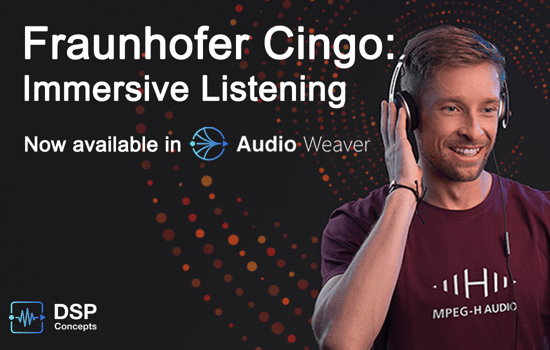
The Audio Weaver IP Ecosystem: Best-in-class Technologies from Leading Brands
The increasing complexity of audio-enabled devices is creating new challenges for product makers. DSP Concepts and its audio technology partners are making it easier for manufacturers to improve their product performance and keep up with the latest features and consumer demands. By utilizing a...
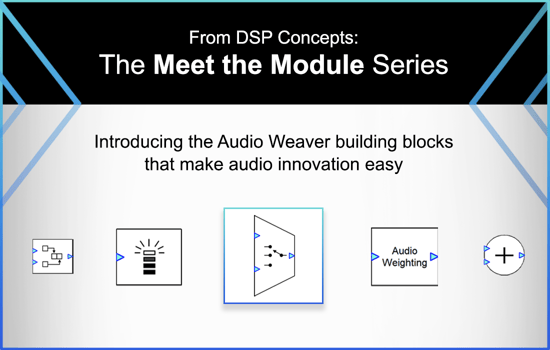
Meet the Module: Multiplexor
The Meet the Module blog series provides insight into the function and purpose of Audio Weaver processing blocks known as modules. In this episode, we look at Multiplexor, a logic element that provides input switching by routing the selected input to the output.
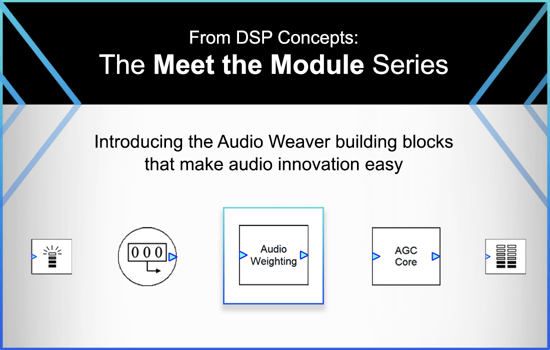
Meet the Module: Audio Weighting
Audio Weaver®from DSP Concepts is a low-code, hardware-independent audio platform that streamlines the development of audio features for a wide range of products.
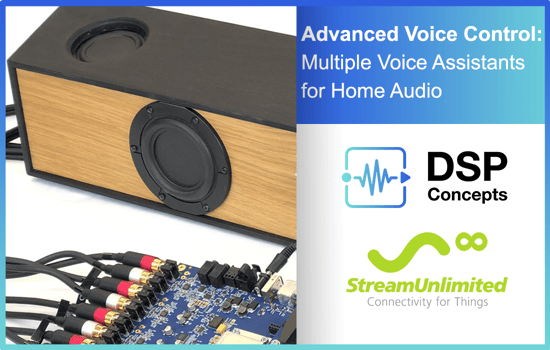
Advanced Voice Control: Multiple Voice Assistants for Home Audio
In a growing and rapidly evolving home audio market — including soundbars and other speaker products — the requirement for OEMs and ODMs to produce feature-rich devices, with the latest in audio technology and a fast time to market, is increasingly only enabled through partnerships with independent...
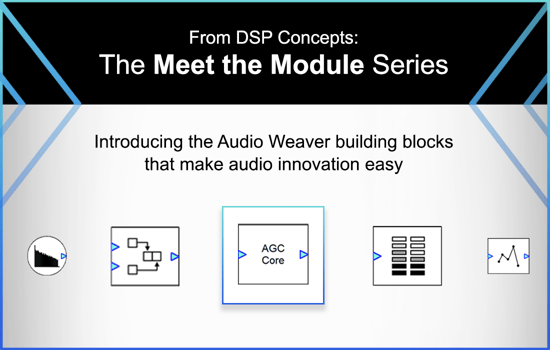
Meet the Module: AGC Core
Audio Weaver® from DSP Concepts is a low-code, hardware-independent audio platform that streamlines the development of audio features for a wide range of products.
By utilizing a PC-based host application for product design, paired with an audio processing engine embedded in the target hardware,...
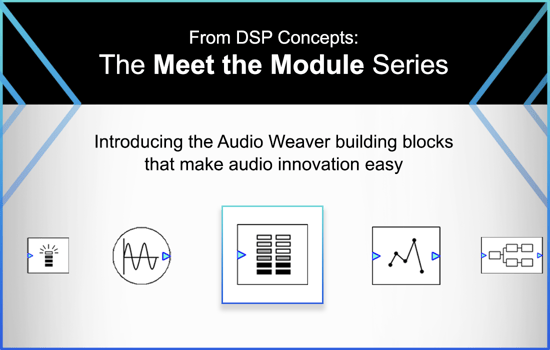
Meet the Module: Meter
Audio Weaver® from DSP Concepts is a low-code, hardware-independent audio platform that streamlines the development of audio features for a wide range of products.
By utilizing a PC-based host application for product design, paired with an audio processing engine embedded in the target...

Optimized for Automotive Audio: SHARC+ and Audio Weaver | DSP Concepts
In a collaboration between DSP Concepts and Analog Devices, the performance of Audio Weaver® Core runtime libraries has been optimized to take full advantage of the SHARC+® core and to leverage the powerful SHARC+ DSP FIR/IIR hardware accelerators.
This optimization effort results in tangible...

A New Frontier for Voice Control: Robotic-Assisted Surgery | DSP Concepts
Robotic-assisted surgery is one of the greatest medical breakthroughs in decades. With these systems, surgeons can access viewpoint control that offers powerful magnification, operate with a level of precision that would be impossible for human hands to match, and make smaller cuts that heal...

How DSP Concepts and Mimi Help People Hear Better | DSP Concepts
True wireless stereo (TWS) earbuds have been one of the most successful innovations in audio. The TWS market has expanded rapidly, and there have been several landmark advancements, such as the inclusion of voice assistants and active noise cancellation. The technology surrounding these devices...
Sensory and DSP Concepts: Collaborating to Empower Product Makers | DSP Concepts
Sensory and DSP Concepts both provide technologies that empower developers to make better audio products. Sensory focuses on improving the user experience through embedded machine learning technologies for wake word detection, command and phrase spotting, natural language processing, and sound...

Advancements in AI and Voice Technology | DSP Concepts
IntroductionIn this article, we dive into the technologies offered by DSP Concepts and Fluent.ai. We take a closer look at how these technologies work together to make better voice-enabled products. We then examine other advancements in machine learning, and the coming opportunities for AI in...
Breaking the Last Barriers to Voice Adoption with Edge AI | DSP Concepts
Edge computing, wherein the provision of services and processing of data occur at the “edge” of a local network rather than through a cloud provider, has prompted a shift away from cloud computing in recent years. Information security and privacy, reduced latency, and an increase in intelligent...
Human-to-Human Communication with Flexible Audio Technology | DSP Concepts
Featured on the Qualcomm Developer Network: integrating voice communication processing into an end product requires careful selection and tuning of hardware and software components to lessen implementation risks and time-to-market. Seamless integration of voice communication, voice UI, and...
DSP Concepts and delResearch Deliver Data over Sound | DSP Concepts
In a collaboration between DSP Concepts and delResearch, the new AirModem data-over-sound technology is available on the Audio Weaver platform. AirModem functions much like a sound-based QR code, enabling IoT device provisioning, proximity detection, two-way acoustic near-field communication...
Audio Weaver Development Keeping Up with the Rising Demand for Voice-Enabled Products | DSP Concepts
Using the Audio Weaver platform, product makers can overcome many of the challenges of designing audio front ends for voice communication. Audio Weaver is a proven development environment that accelerates the design, debugging, and tuning of audio-enabled products. TalkTogether voice...
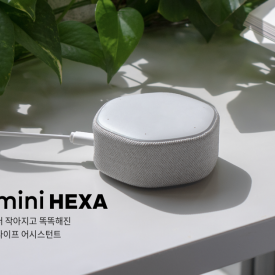
Kakao Enterprise Partners with DSP Concepts to Raise the Bar for Voice Performance in its Mini Hexa Smart Speaker | DSP Concepts
Industry leading audio front end ensures flawless speech recognition regardless of external sound for an optimal user experience
SANTA CLARA, CALIF., JANUARY 19, 2021 – DSP Concepts, whose audio platform powers more than 50 million devices for many of the world’s best consumer and automotive...